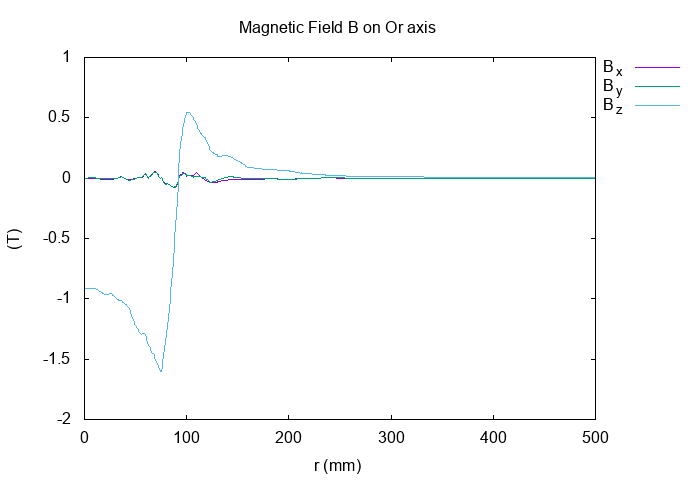Test of MQS + gauge
1. Introduction
In this page, I present the test case of Maxwell Quasi Static Problem with the A-V Formulation with gauge condition for a geometry of torus surrounded by air.
2. Run the calculation
The command line to run this case is :
mpirun -np 32 feelpp_toolbox_coefficientformpdes --config-file=mqs.cfg --cfpdes.gmsh.hsize=5e-3
3. Data Files
The case data files are available in Github here :
-
CFG file - Edit the file
-
JSON file - Edit the file
-
GEO file - Edit the file
4. Equation
Thus \(\Omega\) the domain, comprising the conductor (or superconductor) domain \(\Omega_c\) and non conducting materials \(\Omega_n\) (\(\mathbf{J} = 0\)) like air. Let \(\Gamma = \partial \Omega\) the bound of \(\Omega\), \(\Gamma_c = \partial \Omega_c\) the bound of \(\Omega_c\), \(\Gamma_D\), \(\Gamma_{Dc}\) the bound with Dirichlet boundary condition and \(\Gamma_N\), \(\Gamma_{Nc}\) the bound with Neumann boundary condition, such that \(\Gamma = \Gamma_D \cup \Gamma_N\) and \(\Gamma_c = \Gamma_{Dc} \cup \Gamma_{Nc}\).
We introduce :
-
Magnetic potential field \(\mathbf{A}\) : the magnetic field writes \(\textbf{B} = \nabla \times \textbf{A}\)
-
Electric potential scalar : \(\nabla V = - \textbf{E} - \frac{d \textbf{A}}{d t}\)
We have the conditions :
-
\(\nabla \cdot \mathbf{A} = 0\)
-
\(\mu\) is independant of space
We want to resolve the electromagnetism problem ( with \(\mathbf{A}\) and \(V\) the unknows) :
This equation is obtain from the A-V Formulation with the gauge conditions. The detail calculus are in page MQS + gauge condition.
5. Geometry
The geometry is a quart of torus of conductor surrounded by air.
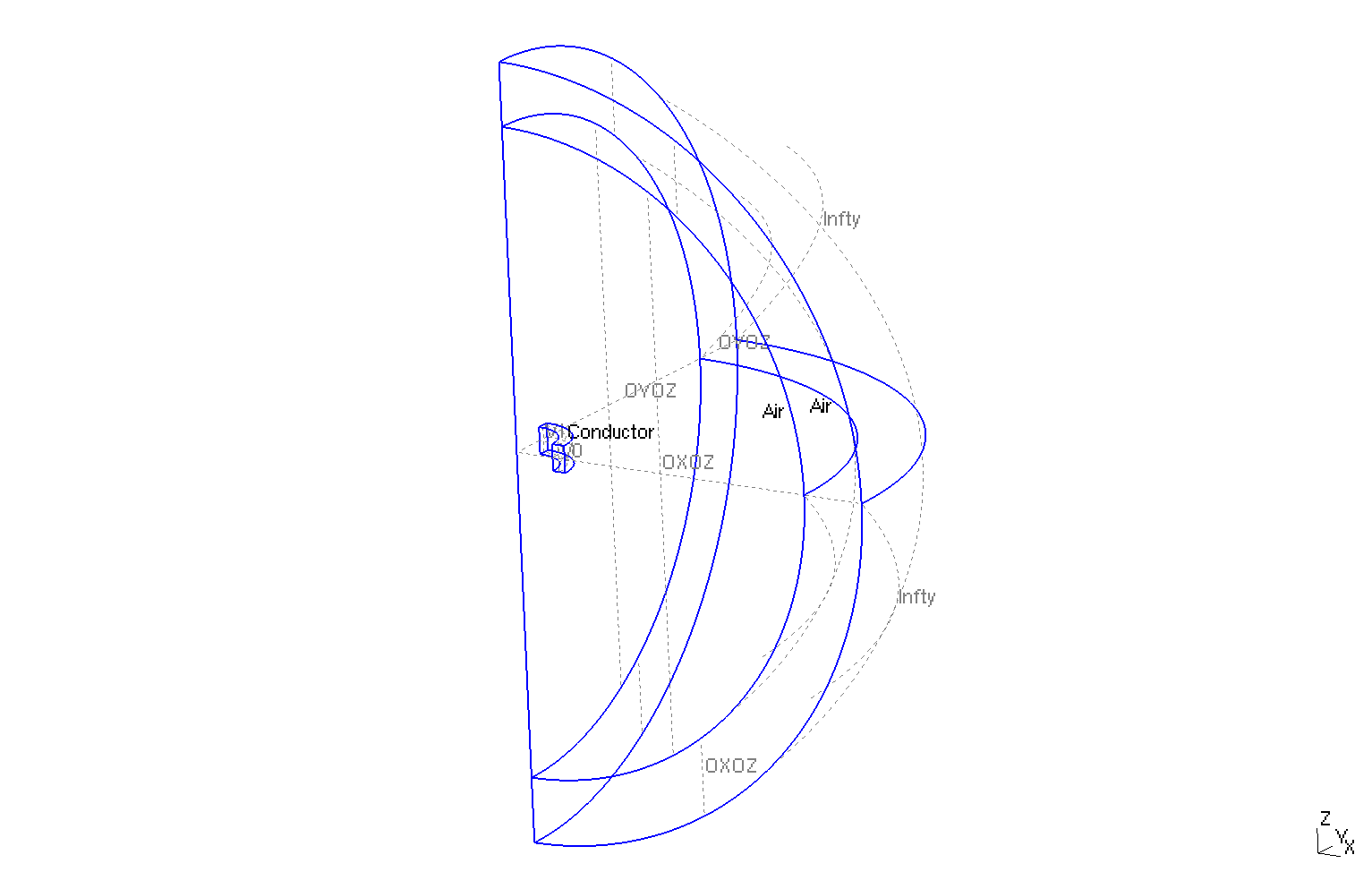
Geometry
|
The geometrical domains are :
-
Conductor(\(\Omega_c\)) : the torus, it is composed of conductive materials-
V0: enter of electrical potential -
V1: exit of electrical potential
-
(V0 \(\cup\) V1 \( = \Gamma_{Dc}\))
-
air(\(\Omega/\Omega_c\)) : the air surroundConductor-
OXOZ: \(OxOz\) plan -
OYOZ: \(OyOz\) plan -
Infty: the rest of bound ofAir
-
Symbol |
Description |
value |
unit |
\(r_{int}\) |
interior radius of torus |
\(75e-3\) |
m |
\(r_{ext}\) |
exterior radius of torus |
\(100.2e-3\) |
m |
\(z_1\) |
half-height of torus |
\(25e-3\) |
m |
\(r_{infty}\) |
radius of infty border |
\(5*r_{ext}\) |
6. Initial/Boundary Conditions
We impose the Dirichlet boundary conditions :
-
For \(V\) equation :
-
On
V0: \(V = 0\) -
On
V1: \(V = \frac{1}{4} \left\{ \begin{matrix} t \text{ on } 0s \leq t < 1s \\ 1 \text{ on } 1s \leq t < 20s \\ t \text{ on } 20s \leq t \end{matrix} \right.\)
-
-
For \(\mathbf{A}\) :
-
On
OXOZandV0: \(A_x = A_z = 0\), we want \(\mathbf{A}\) orthogonal toOXOZandV0 -
On
OYOZandV1: \(A_y = A_z = 0\), we want \(\mathbf{A}\) orthogonal toOYOZandV1 -
Infty: We approximate the problem,Inftyis the physical infty thus \(\mathbf{B}=0\) atInftythus \(\mathbf{A} = 0\).
-
We initialize at \(t=0s\) :
-
\(V = 0\)
-
\(\mathbf{A} = 0\)
On JSON file, the boundary conditions are writed :
"BoundaryConditions":
{
"magnetic":
{
"Dirichlet":
{
"Infty":
{
"expr":"{0,0,0}"
}
},
"Dirichlet_x":
{
"mydir_y":
{
"markers":["V0","OXOZ"],
"expr":0
}
},
"Dirichlet_y":
{
"mydir_y":
{
"markers":["V1","OYOZ"],
"expr":0
}
},
"Dirichlet_z":
{
"mydir_z":
{
"markers":["V0","OXOZ","V1","OYOZ"],
"expr":0
}
}
},
"electric":
{
"Dirichlet":
{
"V0":
{
"expr":"V0:V0"
},
"V1":
{
"expr":"V1:V1"
}
}
}
}
For initial condition, we write nothing in JSON, by default the application put zeros on initialization.
7. Weak Formulation
The weak formulation of A-V Formulation + gauge is :
8. Parameters
The parameters of problem are :
-
On
Conductor:
Symbol |
Description |
Value |
Unit |
\(V0\) |
scalar electrical potential on |
\(0\) |
\(Volt\) |
\(V1\) |
scalar electrical potential on |
\(\frac{1}{4} \left\{ \begin{matrix} t \ \text{on} \ 0s \leq t < 1s \\ 1 \ \text{on} \ 1s \leq t < 20s \\ 0 \ \text{on} \ 20s \leq t \end{matrix} \right.\) |
\(Volt\) |
\(\sigma\) |
electrical conductivity |
\(58e6\) |
\(S/m\) |
\(\mu=\mu_0\) |
magnetic permeability of vacuum |
\(4\pi.10^{-7}\) |
\(kg \, m / A^2 / S^2\) |
-
On
Air:
Symbol |
Description |
Value |
Unit |
\(\mu=\mu_0\) |
magnetic permeability of vacuum |
\(4\pi.10^{-7}\) |
\(kg \, m / A^2 / S^2\) |
On JSON file, the parmeters are writed :
"Parameters":
{
"V0":0,
"V1":"1/4*(t/(0.1*10)*(t<(0.1*10))+((t<(0.5*40))+0*(t>(0.5*40)))*(t>(0.1*10))):t"
}
9. Coefficient Form PDEs
We use the application Coefficient Form PDEs. The coefficient associate to Weak Formulation are :
-
On
Conductor:
Coefficient |
Description |
Expression |
|
damping or mass coefficient |
\(\sigma\) |
|
diffusion coefficient |
\(\frac{1}{\mu}\) |
|
source term |
\(- \sigma \nabla V \) |
|
damping or mass coefficient |
\(\sigma\) |
|
source term |
\(\sigma \, \frac{d \mathbf{A}}{d t}\) |
-
On
Air(the lectrical potential isn’t computed onAir) :
Coefficient |
Description |
Expression |
|
diffusion coefficient |
\(\frac{1}{\mu}\) |
On JSON file, the coefficients are writed :
"Materials":
{
"Conductor":
{
"sigma":58e6, // S.m-1
"mu":"4*pi*1e-7", // kg.m/A2/S2
"magnetic_d":"sigma:sigma",
"magnetic_c":"1/mu:mu",
"magnetic_f":"{-sigma*electric_grad_V_0,-sigma*electric_grad_V_1,-sigma*electric_grad_V_2}:sigma:electric_grad_V_0:electric_grad_V_1:electric_grad_V_2",
"electric_c":"sigma:sigma",
"electric_gamma":"{sigma*magnetic_dA_dt_0,sigma*magnetic_dA_dt_1,sigma*magnetic_dA_dt_2}:sigma:magnetic_dA_dt_0:magnetic_dA_dt_1:magnetic_dA_dt_2"
},
"Air":
{
"physics":"magnetic",
"mu":"4*pi*1e-7", // kg.m/A2/S2
"magnetic_c":"1/mu:mu"
}
}
10. Numeric Parameters
This section show the parameters used to compute the simulation.
-
Size of mesh :
-
On
Conductor: \(0.5 \, mm\) -
On
Infty: \(100 \, mm\)
-
-
Time Parameters :
-
Time step : \(0.1 \, s\)
-
Initial Time : \(0 \, s\)
-
Final Time : \(22 \, s\)
-
-
Element type : \(P1\)
-
Solver : automatic
-
Number of CPU core : \(32\)
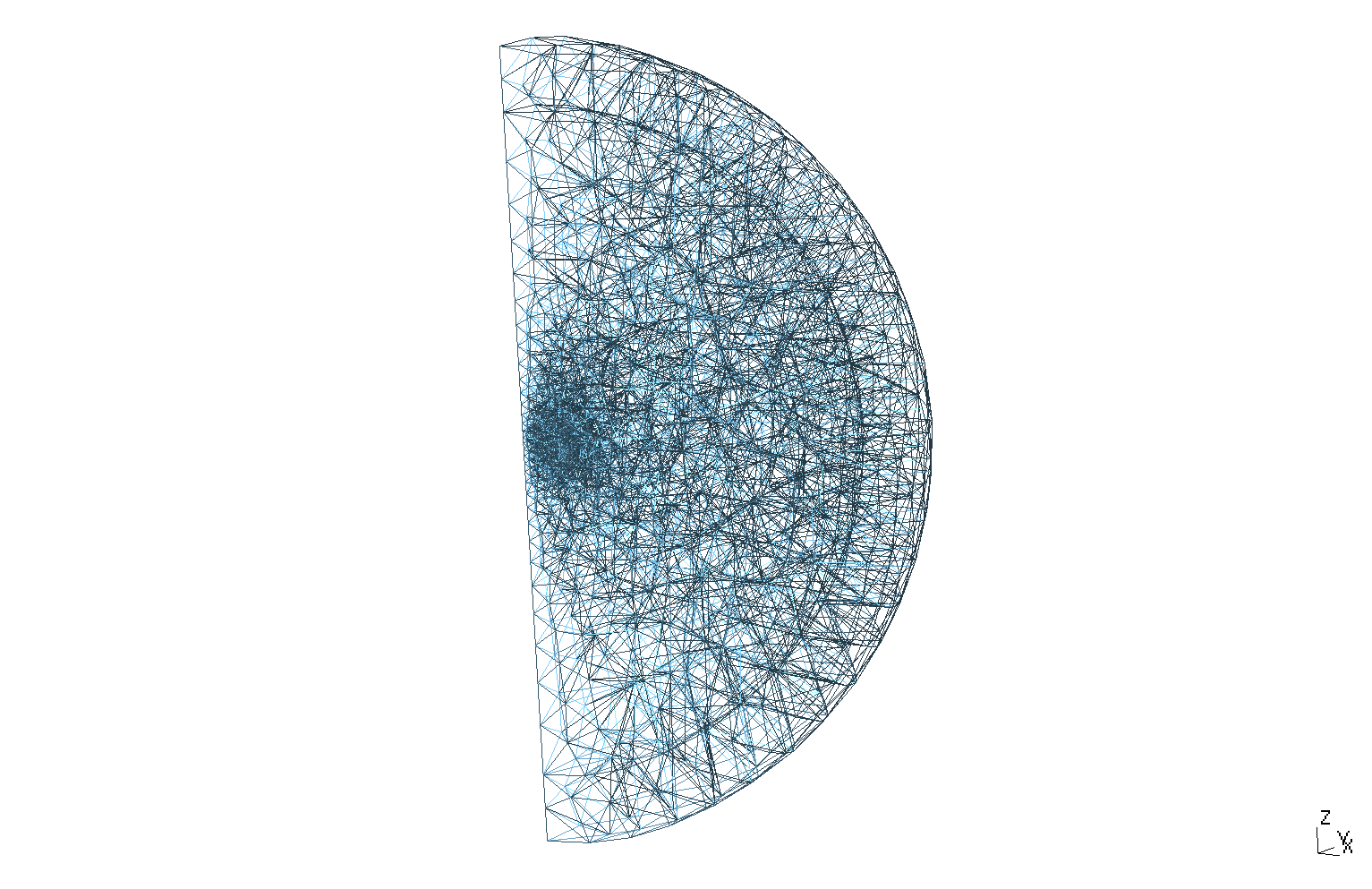
Mesh of Geometry
|
11. Result
11.2. Potential Magnetic Field \(\mathbf{A}\)
I plot the the components of \(\mathbf{A}\) at \(t=20s\) in stationnary state :
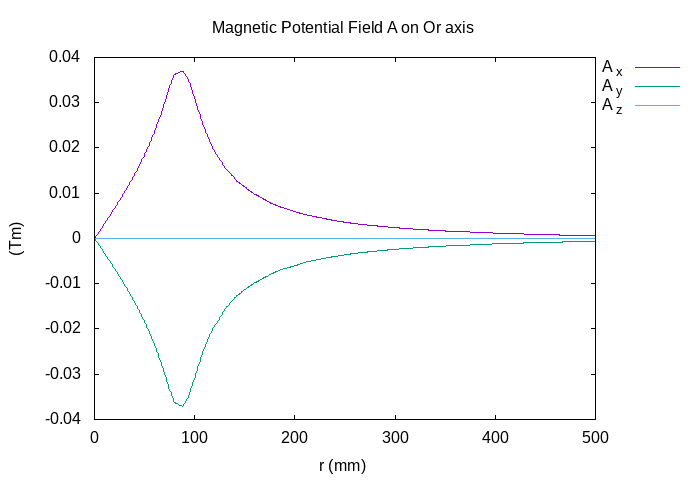
Components of \(\mathbf{A} \, (Tm)\) on Or axis at \(t=20s\)
|
Magnetic Potential Field \(A_x (T.m)\)
|
Magnetic Potential Field \(A_y (T.m)\)
|
As predicted, the z component of potential magentic field \(A_z\) is equal to zeros.
12. Validation
12.1. Exact solution
The analytical solve of potential magnetic field and magnetic field (the cyan curve on plots) is computed by python3’s module MagnetTools.MagnetTools. The module based on paper : spire.
The analytical solve of intensity (and magnetic field) is computed on python3’s script Edit the file.
12.2. Convergence Test
I plot the result of z component of magnetic field \(B_z\) on a radius of tore at \(t=20s\) in stationnary state with exact solution computed with python3’s module MagnetTools.MagnetTools to "validate" the solution :
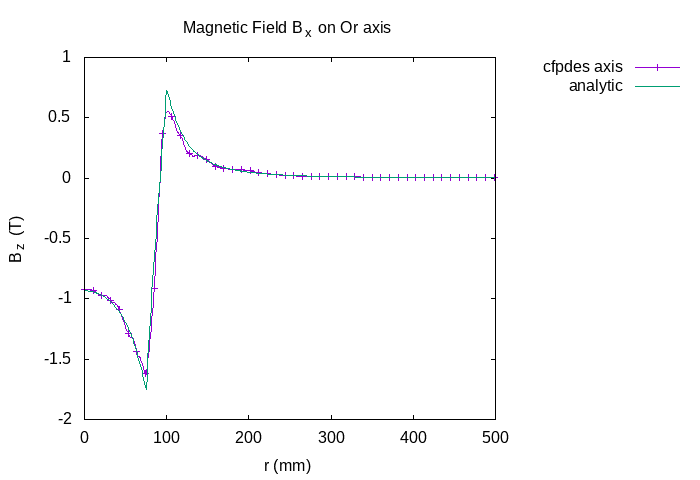
\(B_z (T)\) on Or axis at \(t=20s\)
|
The two curves overlap.
I plot the result of z component of magnetic field \(B_z\) on origin point \(P_0=(0,0,0)\) across time with numerical solution computed with getdp software to "validate" the solution :
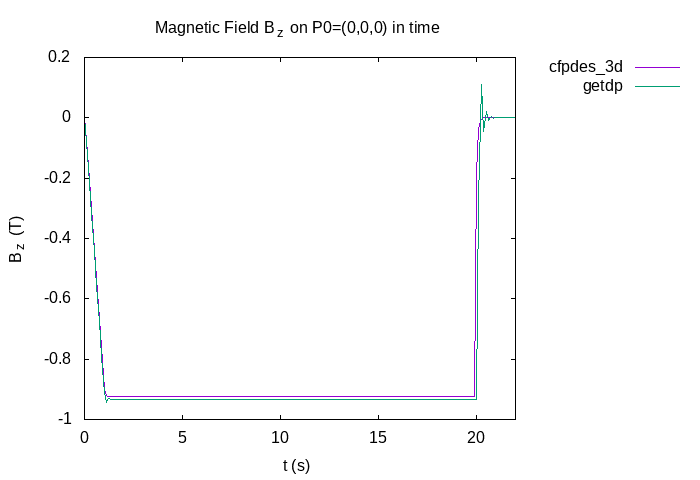
\(B_z (T)\) on \(P_0=(0,0,0)\) across the time
|
The two curves overlap.
We do the same for \(A_{\theta}\) (the orthoradial component in cylindrical coordinates) :
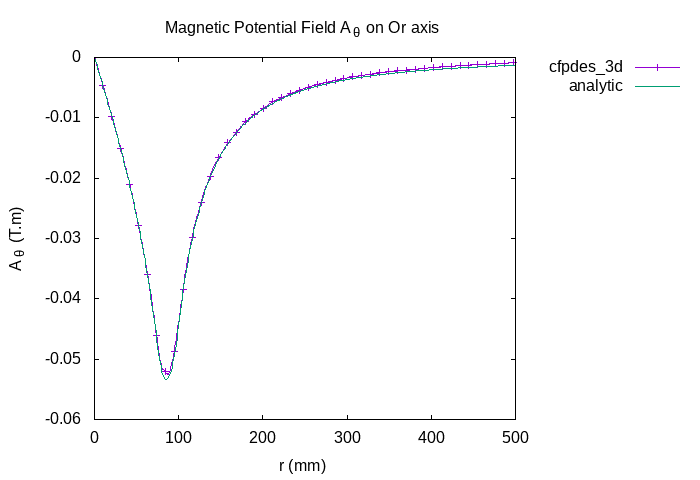
\(A_{\theta} (Tm)\) on Or axis at \(t=20s\)
|
It exist a little difference near of Infty. To obtain better precision, we can increase the radius of Infty to have approximatively 0.
With the last comparisons, we have trust of our method.
13. References
-
Calcul du champ magnétique pour les géométries axisymétriques simples, Christophe Trophime, 2002, unpublished, Download the PDF
